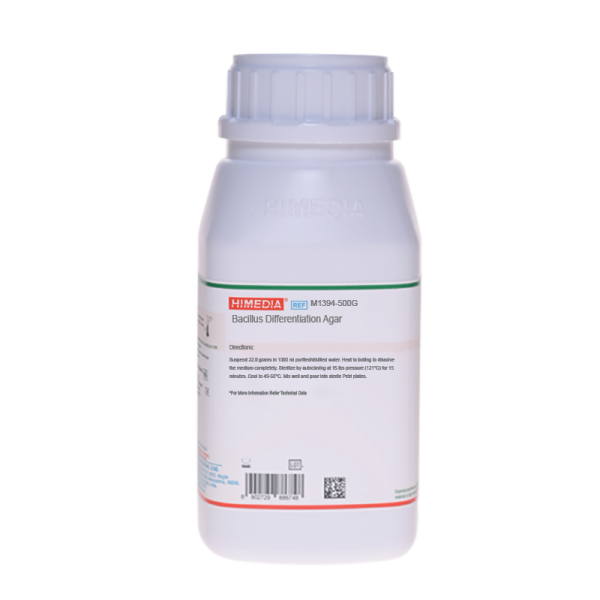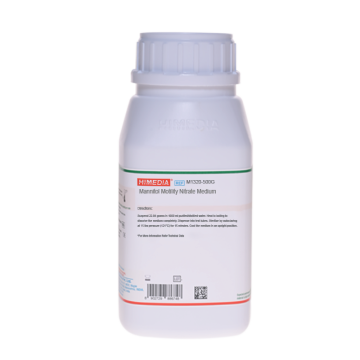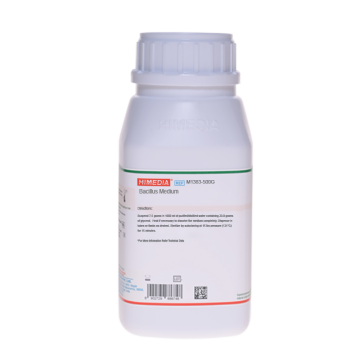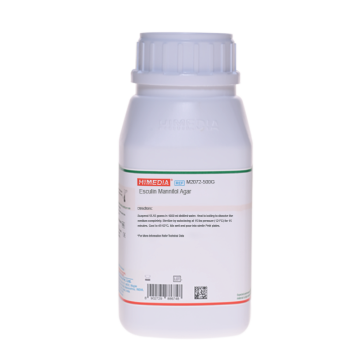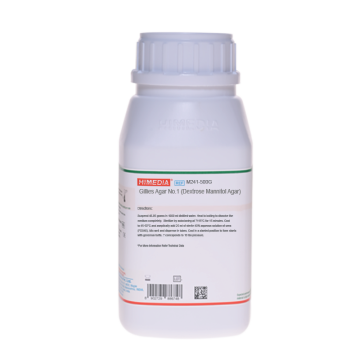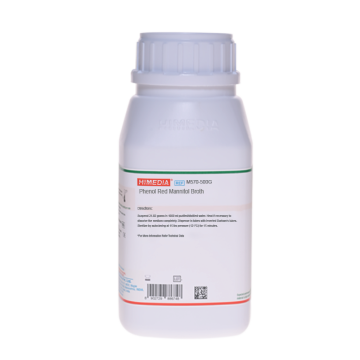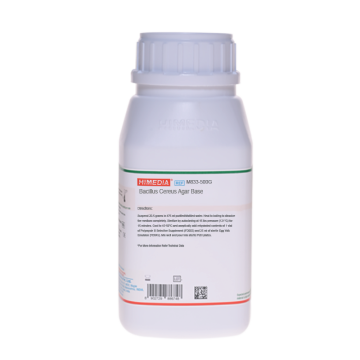 Your enquiry has been submitted
Your enquiry has been submitted
Bacillus Differentiation Agar
Bacillus cereus#CC293D
Intended Use
Recommended for differentiation between Bacillus cereus and Bacillus subtilis based on mannitol fermentation.
Composition
M1394
| Ingredients | Gms / Litre |
|---|---|
| Yeast autolysate | 0.200 |
| Mannitol | 5.000 |
| Monohydrogen ammonium phosphate | 1.000 |
| Potassium chloride | 0.200 |
| Magnesium sulphate | 0.200 |
| Bromo cresol purple | 0.0075 |
| Agar | 15.400 |
| Final pH (at 25°C) | 7.2±0.2 |
**Formula adjusted, standardized to suit performance parameters
Directions
Suspend 22.0 grams in 1000 ml purified / distilled water. Heat to boiling to dissolve the medium completely. Sterilize by autoclaving at 15 lbs pressure (121°C) for 15 minutes. Cool to 45-50°C. Mix well and pour into sterile Petri plates.
Principle And Interpretation
Bacillus is Gram positive, rod-shaped bacteria; can be obligate aerobes or facultative anaerobes (4). Under stressful environmental conditions they produce oval endospores, that can be dormant for extended periods (3). Bacillus cereus causes food-borne illness and Bacillus subtilis is involved in food spoilage like ropiness in bread and other related foods. Bacillus Differentiation Agar is recommended for differentiation between Bacillus cereus and Bacillus subtilis based on mannitol fermentation. Yeast autolysate provide necessary nitrogenous source for growth of Bacillus. Magnesium sulphate and Potassium chloride supports sporulation. Ammonium phosphate maintains buffering action. Bromocresol purple act as a pH indicator to detect mannitol fermentation.
Type of specimen
Isolated Microorganism
Specimen Collection and Handling:
For samples follow appropriate techniques for handling specimens as per established guidelines (1,2). After use, contaminated materials must be sterilized by autoclaving before discarding.
Warning and Precautions :
Read the label before opening the container. Wear protective gloves/protective clothing/eye protection/ face protection. Follow good microbiological lab practices while handling specimens and culture. Standard precautions as per established guidelines should be followed while handling specimens. Safety guidelines may be referred in individual safety data sheets.
Limitations :
- Well isolated colonies must be used.
Performance and Evaluation
Performance of the medium is expected when used as per the direction on the label within the expiry period when stored at recommended temperature.
Quality Control
Appearance
Light yellow to light green homogeneous free flowing powder
Gelling
Firm, comparable with 1.54% Agar gel.
Colour and Clarity of prepared medium
Light purple coloured clear to slightly opalescent gel forms in Petri plates.
Reaction
Reaction of 2.2% w/v aqueous solution at 25°C. pH : 7.2±0.2
pH
7.00-7.40
Cultural Response
Cultural characteristics observed after an incubation at 35-37°C for 18-24 hours.
| Organism | Inoculum (CFU) | Growth | Recovery | Colour |
|---|---|---|---|---|
| Bacillus cereus ATCC 10876 | 50-100 | luxuriant | >=70% | colourless |
| Bacillus subtilis subsp. spizizenii ATCC 6633 | 50-100 | luxuriant | >=70% | yellow |
(00003*)
Key: *Corresponding WDCM numbers.
Storage and Shelf Life
Store between 10-30°C in a tightly closed container and the prepared medium at 20-30°C. Use before expiry date on the label. On opening, product should be properly stored dry, after tightly capping the bottle in order to prevent lump formation due to the hygroscopic nature of the product. Improper storage of the product may lead to lump formation. Store in dry ventilated area protected from extremes of temperature and sources of ignition. Seal the container tightly after use. Product performance is best if used within stated expiry period.
Disposal
User must ensure safe disposal by autoclaving and/or incineration of used or unusable preparations of this product. Follow established laboratory procedures in disposing of infectious materials and material that comes into contact with sample must be decontaminated and disposed of in accordance with current laboratory techniques (1,2).
Reference
- Isenberg, H.D. Clinical Microbiology Procedures Handbook 2nd Edition.
- Jorgensen, J.H., Pfaller, M.A., Carroll, K.C., Funke, G., Landry, M.L., Richter, S.S and Warnock., D.W. (2015) Manual of Clinical Microbiology, 11th Edition. Vol. 1.
- Madigan M; Martinko J (editors). (2005). Brock Biology of Microorganisms (11th ed.). Prentice Hall.
- Turnbull PCB (1996). Bacillus. In: Barron's Medical Microbiology (Baron S et al., eds.) (4th ed.). Univ of Texas Medical Branch.
| Product Name | Bacillus Differentiation Agar |
|---|---|
| SKU | M1394 |
| Product Type | Regular |
| Physical Form | Powder |
| Origin | Animal Free (Microbial) |
| Packaging type | HDPE |
| References | 1. Turnbull PCB (1996). Bacillus. In: Barron's Medical Microbiology (Baron S et al., eds.) (4th ed.). Univ of Texas MedicalBranch. |
| Customized Product Available | No |



